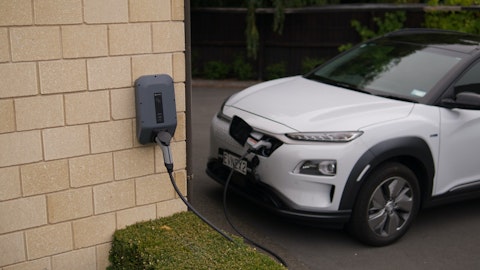Operator: Can you share how many dealerships you have provided initial EV charging infrastructure designs or proposals to?
Craig Denson: Good question. We’re shifting our approach away from publishing our progress on the dealership sector as it does not provide a fulsome metric for evaluating Charge. So while dealerships who are early adopters to mandates continue to be strategic. Moving forward, we will plan to expand into multiple market segments. We believe the number of installations, the expansion across states and backlog are more relevant today. Going forward, we will focus on these aspects and as necessary, introduce new metrics.
Operator: Can dealerships get government funding to install public EV charging infrastructure?
Craig Denson: If it’s a public charging station, the dealer has a chance of getting funding. However, today, what we are seeing is that in over 95% of the case is the dealer is not installing fast charging that is available to the public.
Operator: We will now move to questions submitted by Amit Dayal with H.C. Wainwright. Can you expand on the future strategy being put in place under new leadership?
Craig Denson: Thanks, Amit. As we covered in our remarks, as per our August press release, we’re undergoing a comprehensive review of our business. There are three fundamental objectives in place that are designed to steer the company’s future growth and set the foundation to deliver shareholder value. The first is our focus on developing a comprehensive strategic plan, which includes a thorough evaluation of our business segments, competitive analysis of the external environment, alignment of our organic growth and M&A strategy and effective allocation of capital. As part of this plan, management and the Board will evaluate our talent, succession planning and corporate governance, making appropriate enhancement and implementing a framework for accountability.
Two, we are instituting a robust framework for external communication, fostering transparency and disseminating updates on our progress towards strategic milestones. And finally, we’re focused on deploying initiatives that are geared toward integrating our products and services across our Infrastructure operating segments while driving cost synergies across our organization. This strategic objective is aimed at nurturing cross-functional collaboration and facilitating full utilization of our existing internal capabilities, propelling us towards scalability and profitability. These efforts are underway. I’m encouraged with our progress to date, and we look forward to sharing more updates as we move forward.
Operator: Any change in outlook with respect to EV charging deployment expectations from interest rate environment?
Leah Schweller: Good morning Amit, so for Charge specifically, we are not seeing material impacts to our customers. Most of our clients are not financing their EV charging infrastructure projects, so interest rates are not necessarily a direct factor. That being said, you can’t read the business section without looking on interest rates and the Fed’s actions to cool inflation. Higher interest rates, stalling house prices and the volatile stock market are likely factors causing some hesitation for EV buyers. While recent news reports continue to forecast growth in EV sales, albeit at a lower rate in the short term, the lack of EV charging infrastructure is one of the challenges, but we see this as an opportunity for Charge.
Operator: Is the stock under pressure from any balance sheet-related needs?
Leah Schweller: Without speculating on our share price, we are managing our balance sheet, and we have the proper liquidity to meet our operational needs and service our debt.
Operator: Can you provide a sense of an outlook for the Telecommunications segment of your business and the drivers?
Leah Schweller: Yes. Thanks. We’ve talked about this for a few quarters now. We anticipate a continued decline in wholesale voice volume with only potential increases due to unforeseen global events. Recognizing this expected decline, we enhanced our product set earlier this year to include SMS capabilities, which offers a more favorable profit margin and market opportunity. While this transition will take time to fully ramp up, we are pleased with the early results. Looking ahead, we view SMS as a contributor to the Telecommunications segment in 2024.
Operator: The next set of questions is from Pavel Molchanov with Raymond James. Is there an appetite for splitting the company’s infrastructure segments between telecom and EV?
Craig Denson: Thanks. I’d say not at this time. Our Infrastructure segment encompasses all of our electrical businesses, which includes EV charging, wireless and broadband and commercial lighting, solar and energy storage projects.
Operator: It has been 100 days since the acquisition of Greenspeed. In general terms, how has it been going with this new business?
Craig Denson: I’m pleased with how it’s going. Paul Williams, the former owner of Greenspeed, who became the lead of our EV charging infrastructure team has done an excellent job in integrating the Charge EV infrastructure with the business of Greenspeed. We’re finding a lot of efficiencies within the now combined EV charging business, and I’m happy with the progress to date. The fact that we’ve taken our single EV product and added both commercial solar and lighting product sets, while increasing our availability to execute projects from 13 to 25 states, really demonstrates the value of this deal.
Operator: Thank you for reiterating your commitment to positive adjusted EBITDA in first quarter 2024. To what extent does this target depend on macro conditions such as interest rates, etcetera?

